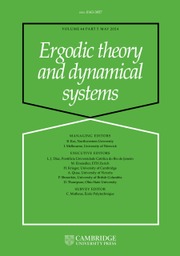Article contents
Measurable rigidity for Kleinian groups
Published online by Cambridge University Press: 01 June 2015
Abstract
Let  $G,H$ be two Kleinian groups with homeomorphic quotients
$G,H$ be two Kleinian groups with homeomorphic quotients  $\mathbb{H}^{3}/G$ and
$\mathbb{H}^{3}/G$ and  $\mathbb{H}^{3}/H$ . We assume that
$\mathbb{H}^{3}/H$ . We assume that  $G$ is of divergence type, and consider the Patterson–Sullivan measures of
$G$ is of divergence type, and consider the Patterson–Sullivan measures of  $G$ and
$G$ and  $H$ . The measurable rigidity theorem by Sullivan and Tukia says that a measurable and essentially directly measurable equivariant boundary map
$H$ . The measurable rigidity theorem by Sullivan and Tukia says that a measurable and essentially directly measurable equivariant boundary map  $\widehat{k}$ from the limit set
$\widehat{k}$ from the limit set  $\unicode[STIX]{x1D6EC}_{G}$ of
$\unicode[STIX]{x1D6EC}_{G}$ of  $G$ to that of
$G$ to that of  $H$ is either the restriction of a Möbius transformation or totally singular. In this paper, we shall show that such
$H$ is either the restriction of a Möbius transformation or totally singular. In this paper, we shall show that such  $\widehat{k}$ always exists. In fact, we shall construct
$\widehat{k}$ always exists. In fact, we shall construct  $\widehat{k}$ concretely from the Cannon–Thurston maps of
$\widehat{k}$ concretely from the Cannon–Thurston maps of  $G$ and
$G$ and  $H$ .
$H$ .
Information
- Type
- Research Article
- Information
- Copyright
- © Cambridge University Press, 2015
References
- 1
- Cited by

